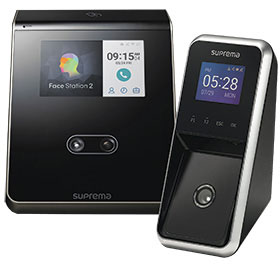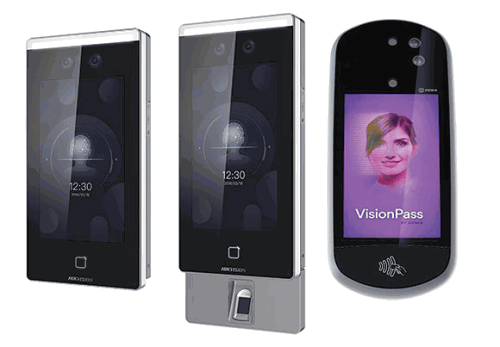

The coronavirus has made touchless biometrics an important consideration for access control installations globally, including for residential estates.
While we saw a dramatic increase in the availability and interest in facial recognition before the pandemic, this is a technology everyone is considering today, with the virus quieting many of the privacy concerns of the past.
It would not be unreasonable to say that the quality of facial recognition systems has improved dramatically, even in comparison to the systems available a year or two ago. However, facial recognition systems are still more expensive than your traditional fingerprint solutions and whether prices will decline further due to mass adoption remains to be seen.
That’s not to say that facial recognition is the only biometric modality out there that supports touchless identification and verification. Other systems that could be considered are touchless fingerprint readers, palm vein and iris biometrics, voice recognition and more that are not yet in the mainstream. And, of course, they may not all be suited for residential needs.
Hi-Tech Security Solutions approached a number of local biometric leaders to find out more about touchless technologies in general, as well as what the uptake (or not) in the residential market is like.

Touchless is where it’s at
Walter Rautenbach, managing director of neaMetrics, Suprema SA distribution, says there has been a marked increase in interest in touchless biometrics over the past few months, not only in Africa, but internationally.
He says facial recognition is mostly in demand now due to the general increase in popularity of this modality, even before COVID-19, due to the ease of use and the number of available products. What currently makes this more popular in light of the pandemic is its potential to also detect if people are wearing masks and to simultaneously incorporate temperature screening.
“I say the latter with caution as face masks make face recognition more difficult and temperature screening actually uses totally different technology,” explains Rautenbach. “Vendors have been adjusting their face algorithms to incorporate the utilisation of masks successfully, but one is just never sure how the retesting of algorithms was done in such a short period of time, what shortcuts were taken and if accuracy was sacrificed.
“Distributors, system integrators and end users must, at all times, ensure that the technology works and that it is not just fad-addressing, make-a-quick-buck solutions,” he warns.
He also notes that it is difficult to gauge if the ‘extreme urgent want’ for touchless will remain or if touch biometrics will return to their glory as we return to normality. It is also extremely difficult to measure if the need in specific verticals, such as residential, will be more demanding than others.
“Our two month experience has seen a 4000% increase in cards and mobile credentials as people rush to have some control rather than none with the sudden disabling of touch technology.”

Not all about the face
Nicolas Garcia, sales director (Biometric Terminals), Middle East and Africa at IDEMIA, agrees that there has been an increase in demand for contactless biometrics due to the current context. He says IDEMIA currently receives requests that are balanced between facial recognition and fingerprints, and that most of these are ‘real projects’.
“Nevertheless, we also do continue to receive requests for our touch-based fingerprint terminals, as clients have integrated our cleaning/sanitisation recommendations,” Garcia says.
“In the residential market, we do observe a particular interest for contactless biometric access control. We have historically been quite active in this vertical in South Africa. Gated community security managers understand that with a device like MorphoWave installed at entrance gates, they can provide both security and convenience to residents who can wave their hand through their car window, in a quick and easy hand gesture.”

Hikvision South Africa’s Tim Yen also echoes the above sentiments, noting, “We have seen a marked increase in interest for touchless biometrics. A lot of companies and institutions are looking to migrate to touchless biometrics due to the current climate. It certainly is still early days, but the demand is now there for this kind of technology and we already have several large institutes in various verticals such as education, commercial, logistics, mining and manufacturing doing proof-of-concept projects, if not outright buying in to our solutions.”
Finally, David Corder, general manager at Saflec Systems, backs Garcia up in saying that the company has noticed more interest in other forms of touchless biometrics. Chief among them are facial recognition and the MorphoWave reader. As a side note, he has also noticed that some customers who were being pushed to take out their fingerprint readers have opted to revert to card-only access, “which is an interesting regression”.
Reliability and trust
Focusing on facial recognition specifically, the issue with this technology in the past is the perceived unreliability of the biometric readers in recognising and verifying identities. While there are definite improvements in the accuracy of facial recognition (as well as in other touchless technologies), has enough been done to create the trust people have in, for example, fingerprint biometrics?
Rautenbach takes a practical approach on this issue, noting that the user’s selected manufacturer must provide them with the certified false acceptance rates of the product of interest, and these should match prescribed standards – independent of whether it is for face, finger, touch or no-touch. “Face has been on the rise, even before the explicit need for touchless. Part of the reason for this is the increase in data, deep learning and the continuous improvement based on dataset size increases, and the upward curve will continue steeply for many years to come.”
An area where touchless has not made significant inroads to date, he adds, is in the law enforcement world where entire countries have databases of ‘touch fingerprints’. “Although it is, in a way, the same modality and comparable in one way, it is not in another. The performance of touchless finger capture over legacy touch finger databases (as you left it at the crime site through touch) is not that good. It can still be compared by a fingerprint expert, but the data that is captured looks different and touch ‘flattens’ it, where touchless has a curve. This is not a limitation that will exist forever as deep learning learns to flatten the curve and up performance, but it is a concern at the moment.”
With reference to IDEMIA’s two touchless products, Garcia says NIST’s latest contactless-to-contact fingerprint capture evaluation shows that contactless fingerprint capture is getting very close to the most advanced contact technologies. “In this evaluation, MorphoWave technology has emerged as the best performing contactless device in the industry.
“For facial recognition, we propose VisionPass, that uses similar high-performance and accurate algorithms, including anti-spoofing to defeat attempts to fool the reader with photographs or 3D masks. To cope with fear about privacy invasions, we have included an ‘intent area’ which is 70 cm from the device, so that people passing by beyond that distance cannot be accidentally ‘caught’ by the device.”
When deciding between fingerprints and facial recognition, Garcia says it is up to customers to decide, based on their own experience and the preferences and sensibilities of users (for instance, residents of gated communities), as to which technology they prefer.
Yen adds that in the access control fields, facial recognition technology has already been used in overseas markets for more than a decade. “Currently our recognition frontier algorithm is called deep learning; it continuously improves verification accuracy when the facial templates database gets bigger. In other words, this technology has only gotten better with time. Currently our readers reach up to 90% accuracy in terms of face matching and I would encourage prospective end users to come and see the technology for themselves.”

What’s on the market?
Given the interest in all things touchless, there are obviously a number of new and improved solutions available to estates. Corder says Saflec is doing quite a number of integration projects to ensure that touchless biometric systems can be used seamlessly with its technologies.
“We have already integrated the CMITech EF-45 iris scanner. This product has a recognition rate of less than one second across a 10 000-person database. And as noted above, Saflec has also fully integrated the MorphoWave contactless fingerprint scanner as well as the Virdi AC-7000 facial recognition device. This has a database of 60 000 faces when used for 1:1 matching, and 3000 when used as a 1:N device.”
Hikvision also offers a wide range of facial recognition products, says Yen. This includes camera-based facial recognition that has the intelligence to track, trace and identify individuals over multiple sites. “This kind of tech is fantastic for institutions that are looking at fraudulent behaviours or would like to build trends such as demographic statistics for marketing purposes.”
In addition, the company has access-based facial readers that incorporate a facial, fingerprint and card reader all in one; as well as facial readers that have temperature measurement built in with AI intelligence to also enforce mask-wearing policies.
For IDEMIA, Garcia says the MorphoWave Compact is a touchless fingerprint reader that scans four fingerprints through 3D images in less than 1 second by a quick and easy contactless hand gesture. Each device can scan up to 50 users per minute, with up to 100 000 users in the database. The device operates both indoors and outdoors.
“VisionPass is the equivalent for facial recognition,” notes Garcia. “Its advanced 2D, 3D and infrared camera set can scan up to 30 people per minute with no action on their side. The device scans people between 1,20 m and 2,00 m away, copes with face changes (hat, beard, glasses, etc.) and different angles. It also works efficiently with all face types and under all lighting conditions, and it defeats spoofing attempts.”
In addition, he explains that Augmented Vision is a software suite from IDEMIA that is plugged into existing CCTV systems and adds a facial recognition layer to provide real-time surveillance and access control capabilities (alert management, condition door opening, intrusion detection of unknown/unwanted people, etc.) or post-event investigation services.
Suprema is not a new player in the world of touchless biometrics, states Rautenbach, with its initial launch of the FaceStation being in 2011. “Subsequently Suprema launched the FaceStation 2 in 2017 and the FaceLite in 2019, increasing recognition speeds and the number of supported identifications by 300%. In 2019 we had some secret revelations of Suprema’s new high-end face terminal, now geared for outdoor use and increasing performance by over 1000%.
“Yes, the amount of zeroes are correct and a true reflection of the improvements in facial biometric algorithms and the aid lent to it through deep learning. This does not mean the previous products are inferior, it just means the accuracy and speed have increased so much that the number of users that can be reliably processed in the same time has increased.”
Suprema’s facial recognition uses infrared 2D/3D modelling, which automatically offers high accuracy, live face detection and which is not susceptible to light (operates seamlessly in the dark and up to 25 000 lux). It is also not discriminatory, with the same performance for any skin colour. Integration with leading thermal camera providers also tightly integrates temperature screening that can deny access and create central alerts where out-of-bound temperatures are detected.
The launch of Suprema’s mobile credential in 2019 is another product drawing interest in terms of the move to touchless technologies. This product has its own new company, Moca Inc., and the AirFob brand (https://mc.mocainc.com/en/), with functionality extended to Suprema’s access range as well as to products outside of Suprema’s terminals.
The options are there for the choosing. However, as Rautenbach advises, selecting the right option for your estate is not that simple. “If your manufacturer of choice doesn’t offer reasonably affordable touchless, then I believe you should be looking for an alternative as they will not be around for long. Just be aware that all touchless, especially face, are not the same. Make sure that you understand the difference between visual face, the impact of skin colour, why liveness detection is important, and how light can influence your implementation. To make things easier for yourself, find a partner that you can trust and that can provide you with the scientific data explaining what works and what does not.”
For more information contact:
• Hikvision South Africa, +27 87 701 8113, [email protected], www.hikvision.com
• IDEMIA, +27 11 601 5500, [email protected], www.idemia.com
• Saflec Systems, +27 11 477 4760, [email protected], www.safsys.co.za
• Suprema, +27 11 784 3952, [email protected], www.suprema.co.za
| Tel: | +27 10 085 8300 |
| Email: | [email protected] |
| www: | www.hikvision.com/africa/ |
| Articles: | More information and articles about Hikvision South Africa |
| Tel: | +27 11 477 4760 |
| Email: | [email protected] |
| www: | www.saflec.com |
| Articles: | More information and articles about Saflec |
| Tel: | +27 11 601 5500 |
| Email: | [email protected] |
| www: | www.idemia.com |
| Articles: | More information and articles about IDEMIA |
| Tel: | +27 11 784 3952 |
| Email: | [email protected] |
| www: | www.suprema.co.za |
| Articles: | More information and articles about Suprema |
| Tel: | +27 11 543 5800 |
| Email: | [email protected] |
| www: | www.technews.co.za |
| Articles: | More information and articles about Technews Publishing |

© Technews Publishing (Pty) Ltd. | All Rights Reserved.